MILK TEETH — opening new exhibition 1st of February

Exhibition opening: 1st February, 6 pm
Participating artists:
Tomasz Baran
Natalia Bażowska
Michał Gayer
Łukasz Jastrubczak
Szymon Kobylarz
Bartosz Kokosiński
Daria Malicka
Dominik Ritszel
Michał Smandek
Monika Szwed
Erwina Ziomkowska
Curator: Marta Lisok

‘Milk Teeth’ — after exibition resume with pictures and texts The bilingual catalogue of the project authored by Magdalena Machno includes reproductions of artworks photographed by Barbara Kubska, as well as texts written...

Dreams about teeth falling out are considered to be a bad omen. Supposedly, they indicate a change, a loss, an illness or a disaster about to come. Yet, there is nothing unnatural about teeth falling out, especially the milk ones, which first become loose when pushed around with the tongue, then hang by thin threads, and finally can easily be pulled out with one swift motion. It is an inevitable course of events, even if you look after your teeth, avoid sweets and brush them often enough. Although they lack the charm of animal fangs, and their size is not as impressive as an adult's teeth, you can still keep them as a precious treasure, albeit a bit disgusting — an old, worn-out part of yourself. They are small, decayed, and inconspicuous-looking, quite unlike the world surrounding a milk-toothed child, which seems to be so much more vivid, expansive and dangerous. Untroubled childish boredom can accommodate careful observation and deep analysis, possibly for the last time ever. Hypersensitivity.
Unlike in Western European countries, Polish children, when they lose their first teeth, are not visited by a tooth fairy. Nobody leaves a small gift under their pillow in return for this ambiguous trophy. There is no one who can help them go through this process, which is only the beginning of further changes in their bodies. So they have to go through this rite of passage alone. Milk teeth fall out, leaving behind dark, unsightly holes, which will not disappear for a few months.
The exhibition Milk Teeth showcases works by eleven artists, whose works — paintings, objects, installations, videos and others — could be described as unaccomplished, in-between, incoherent. Their creation was accompanied by different anecdotes and contexts, and their aim is to force the audience to temporarily return to the state of increased alertness associated with childhood.
The artists present some private mythologies and old stories with blank spots. The formation process of these mostly fictional memories remains a secret. No one knows why these particular memories are considered worth revisiting, why these are stripped of their status of phantasms for the duration of the exhibition.
At the beginning of their work, the Milk Teeth artists showed certain reserve, which later evolved into great enthusiasm as they continued scraping off outer layers and yellowed wallpapers, leafing through diaries, questioning their relatives, going through drafts of their obliterated works that had been put away at the back of a drawer, the unsuccessful and damaged ones. The artists dug up long-forgotten experiences and concepts, which are ungroomed, written-off, makeshift. When dragged out into daylight, some of them seem sloppy and embarrassing.
The layout of the exhibition refers to a lumber room or an attic with its unique gravitational field for forgotten stuff. It has been designed to function as a ruin, an archaeological dig, space resembling the spongy structure of our memories, abounding in cracks, mistakes, repetitions, space that needs to be filled and completed with our own explanations. It is a place which entices us with a promise of a blameless dive into somebody else's (nobody's) past.









